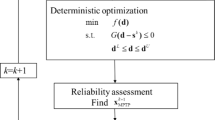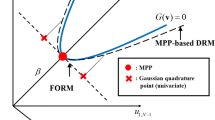Abstract
Conventional most probable point (MPP)-based dimension reduction methods (DRM) show better accuracy in reliability analysis than first-order reliability methods (FORM), and thus have been successfully applied to reliability-based design optimization (RBDO). However, the MPP-based DRM requires additional function evaluations to improve accuracy of probability of failure estimation which could be computationally expensive, and thus leads to reduction in efficiency. Therefore, in this paper, we propose an MPP-based approximated DRM (ADRM) that performs one more approximation at MPP to pursue accuracy of DRM while maintaining efficiency of FORM. In the proposed method, performance functions will be approximated in the original X-space with simplified bivariate DRM and linear regression using available function information such as gradients obtained during previous MPP searches. Therefore, evaluation of quadrature points can be replaced by the proposed approximation. In this manner, we eliminate function evaluations at quadrature points for reliability analysis, so that the proposed method requires function evaluations for MPP search only, which is identical with FORM. In RBDO where sequential reliability analyses in different design points are necessary, ADRM becomes more powerful due to accumulated function information, which will lead to more accurate approximation. To further improve efficiency of the proposed method, several techniques, such as local window and adaptive initial point, are proposed as well. Numerical study verifies that the proposed method is as accurate as DRM and as efficient as FORM by utilizing available function information obtained during MPP searches.







Similar content being viewed by others
References
Adhikari S (2004) Reliability analysis using parabolic failure surface approximation. J Eng Mech 130(12):1407–1427
Arora J (2004) Introduction to optimum design. Elsevier
Atkinson KE (2008) An introduction to numerical analysis. John Wiley & Sons
Breitung K (1984) Asymptotic approximations for multinormal integrals. J Eng Mech 110(3):357–366
Cho H, Bae S, Choi KK, Lamb D, Yang RJ (2014) An efficient variable screening method for effective surrogate models for reliability-based design optimization. Struct Multidiscip Optim 50(5):717–738
Cho H, Choi KK, Lee I, Lamb D (2016) Design sensitivity method for sampling-based RBDO with varying standard deviation. J Mech Des 138(1):011405
Denny M (2001) Introduction to importance sampling in rare-event simulations. Eur J Phys 22(4):403
Guo X, Bai W, Zhang W (2009a) Confidence extremal structural response analysis of truss structures under static load uncertainty via SDP relaxation. Comput Struct 87(3–4):246–253
Guo X, Bai W, Zhang W, Gao X (2009b) Confidence structural robust design and optimization under stiffness and load uncertainties. Comput Methods Appl Mech Eng 198(41–44):3378–3399
Guo X, Du J, Gao X (2011) Confidence structural robust optimization by non-linear semidefinite programming-based single-level formulation. Int J Numer Methods Eng 86(8):953–974
Hasofer AM, Lind NC (1974) Exact and invariant second-moment code format. J Eng Mech Div 100(1):111–121
Hohenbichler M, Rackwitz R (1988) Improvement of second-order reliability estimates by importance sampling. J Eng Mech 114(12):2195–2199
Kang SB, Park JW, Lee I (2017) Accuracy improvement of the most probable point-based dimension reduction method using the hessian matrix. Int J Numer Methods Eng 111(3):203–217
Lee I, Choi KK, Du L, Gorsich D (2008a) Dimension reduction method for reliability-based robust design optimization. Comput Struct 86(13–14):1550–1562
Lee I, Choi KK, Du L, Gorsich D (2008b) Inverse analysis method using MPP-based dimension reduction for reliability-based design optimization of nonlinear and multi-dimensional systems. Comput Methods Appl Mech Eng 198(1):14–27
Lee I, Choi KK, Zhao L (2011) Sampling-based RBDO using the stochastic sensitivity analysis and dynamic kriging method. Struct Multidiscip Optim 44(3):299–317
Lee I, Noh Y, Yoo D (2012) A novel second-order reliability method (SORM) using noncentral or generalized chi-squared distributions. J Mech Des 134(10):100912
Lim J, Lee B, Lee I (2014) Second-order reliability method-based inverse reliability analysis using hessian update for accurate and efficient reliability-based design optimization. Int J Numer Methods Eng 100(10):773–792
Lim J, Lee B, Lee I (2016) Post optimization for accurate and efficient reliability-based design optimization using second-order reliability method based on importance sampling and its stochastic sensitivity analysis. Int J Numer Methods Eng 107(2):93–108
Madsen HO, Krenk S, Lind NC (2006) Methods of structural safety. Courier Corporation
Melchers RE (1989) Importance sampling in structural systems. Struct Saf 6(1):3–10
Park JW, Lee I (2018) A study on computational efficiency improvement of novel SORM using the convolution integration. J Mech Des 140(2):024501
Rahman S, Wei D (2006) A univariate approximation at most probable point for higher-order reliability analysis. Int J Solids Struct 43(9):2820–2839
Rahman S, Xu H (2004) A univariate dimension-reduction method for multi-dimensional integration in stochastic mechanics. Probab Eng Mech 19(4):393–408
Rao SS (2009) Engineering optimization: theory and practice. John Wiley & Sons
Rosenblatt M (1952) Remarks on a multivariate transformation. Ann Math Stat 23(3):470–472
Rubinstein RY, Kroese DP (2016) Simulation and the Monte Carlo method (Vol. 10). John Wiley & Sons
Seber GA, Lee AJ (2012) Linear regression analysis (Vol. 329). John Wiley & Sons
Tu J, Choi KK, Park YH (1999) A new study on reliability-based design optimization. J Mech Des 121(4):557–564
Tu J, Choi KK, Park YH (2001) Design potential method for robust system parameter design. AIAA J 39(4):667–677
Wei D, Rahman S (2007) Structural reliability analysis by univariate decomposition and numerical integration. Probab Eng Mech 22(1):27–38
Xu H, Rahman S (2004) A generalized dimension-reduction method for multidimensional integration in stochastic mechanics. Int J Numer Methods Eng 61(12):1992–2019
Yoo D, Lee I, Cho H (2014) Probabilistic sensitivity analysis for novel second-order reliability method (SORM) using generalized chi-squared distribution. Struct Multidiscip Optim 50(5):787–797
Youn BD, Choi KK, Park YH (2003) Hybrid analysis method for reliability-based design optimization. J Mech Des 125(2):221–232
Youn BD, Choi KK, Yang RJ, Gu L (2004) Reliability-based design optimization for crashworthiness of vehicle side impact. Struct Multidiscip Optim 26(3–4):272–283
Youn BD, Choi KK, Du L (2005) Enriched performance measure approach for reliability-based design optimization. AIAA J 43(4):874–884
Zhao L, Choi KK, Lee I, Gorsich D (2013) Conservative surrogate model using weighted kriging variance for sampling-based RBDO. J Mech Des 135(9):091003
Funding
This research was supported by the EDISON Program through the National Research Foundation of Korea (NRF) funded by the Ministry of Education, Science and Technology (2014M3C1A6038801).
Author information
Authors and Affiliations
Corresponding author
Additional information
Responsible Editor: Xu Guo
Springer Nature remains neutral with regard to jurisdictional claims in published maps and institutional affiliations.
Rights and permissions
About this article
Cite this article
Jung, Y., Cho, H. & Lee, I. MPP-based approximated DRM (ADRM) using simplified bivariate approximation with linear regression. Struct Multidisc Optim 59, 1761–1773 (2019). https://doi.org/10.1007/s00158-018-2160-7
Received:
Revised:
Accepted:
Published:
Issue Date:
DOI: https://doi.org/10.1007/s00158-018-2160-7




